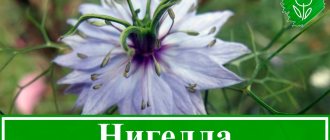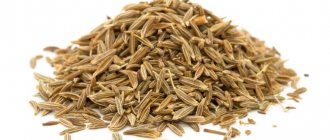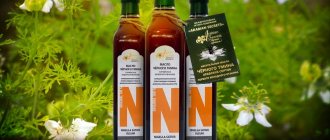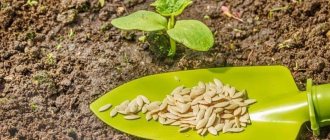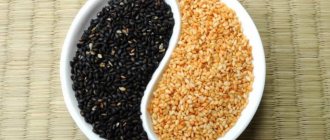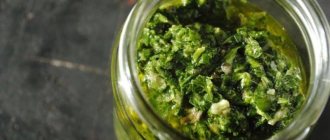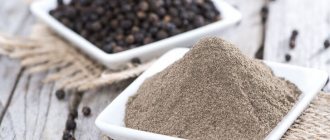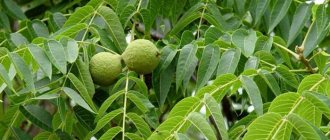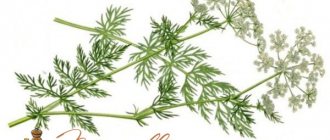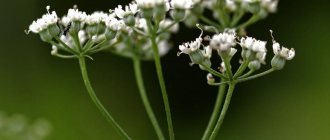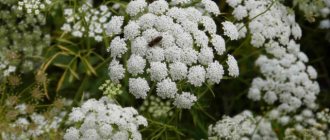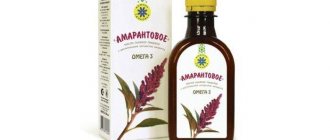Common cumin description of appearance
Cumin is blooming.
Photo: Yandex.Pictures Cumin is a biennial herbaceous plant with a specific pleasant odor. It can grow up to 70 centimeters, but usually the plant's height varies from 30 to 50 centimeters.
The stem of the plant is straight, single, grooved, hollow, branching in the upper part. It ends in a complex umbrella of white or pinkish small flowers. The flowers are collected in twenty-flowered umbels, which are grouped into large complex umbels with a diameter of up to 8 centimeters.
The leaves of caraway seeds are shaped like the tops of garden carrots. At the roots, the rosette of leaves is larger; the higher up the stem, the smaller it becomes. The petioles of the leaves become smaller as they approach the apex.
Wild cumin and its crops begin to bloom in the first half of summer. At this time, the stem elongates in height, becomes woody and thin. The root of the plant grows vertically downwards, it is quite long, fleshy and spindle-like.
The flowers secrete a lot of nectar and are actively visited by insects. The plant is a honey plant; bees cross-pollinate the flowers. Beekeepers claim that bees collect up to 100 kg of honey from 1 hectare of crops.
The brown fruits ripen in July - August. The fruit is an oblong, ovoid two-seeded seed, divided into two semi-fruits with a strong aroma and pleasant taste. Fruit length is from 4 to 6 mm, diameter up to 1 mm.
In the early growing season - before the flowering period, the stem is quite thick, fleshy, tender and fragrant. It has a pleasant taste and can be eaten fresh along with the leaves without any preparation or processing.
What is cumin
What is cumin, medicinal properties and contraindications, what are the beneficial properties of this plant, all this is of great interest to those who lead a healthy lifestyle, monitor their health, and are interested in traditional methods of treatment, including using medicinal herbs and spices . So we will try to answer these questions in the following article.
So:
Cumin (lat. Cárum) is a genus of perennial or biennial plants of the Apiaceae family, of which the most famous species is Caraway (Carum carvi), used as a spice. Representatives of the genus grow in the temperate climates of Europe and Asia.
The root is powerful, fleshy, spindle-shaped, up to 20 cm in length. The leaves are alternate, gradually becoming smaller towards the top of the stem, bi- or triple-pinnate, on short petioles with sheaths, the lower leaves are long-petiolate. In the first year it forms a basal rosette of leaves, in the second year a stem develops.
The stem is smooth, slightly knotted or rounded, hollow, geniculate. As the fruit ripens, the stem gradually turns brown and dries out. Each shoot ends in an inflorescence. The flowers are small, five-petaled, white, deeply notched, collected in a complex umbrella without an involucre or with an involucre consisting of 1–3 whole leaves.
The fruit is an oblong drupe, splitting into 2 half-fruits when ripe. It blooms in June–July, the fruits ripen in July–August in the second year of life. Propagated by seeds. Distributed in the European part of Russia, especially in the southern and southeastern regions, the Caucasus, Western Siberia and Central Asia. Grows in fresh sandy and loamy soils in dry meadows, forest clearings and edges, along roads and roadsides, in pastures.
If you want to grow cumin, buy its seeds. Sow once, and then simply leave several plants with seeds to overwinter. And you will never have problems with the cumin harvest. Sow like carrots.
In German, Austrian, Czech, Scandinavian and Hungarian cuisines, cumin is most widespread. It still gives a characteristic taste to German rye bread, it is used to flavor sauerkraut, salt lard with it and, finally, sprinkle it on jacket potatoes. Swedes always add cumin to their bread, and Hungarians add it to their signature goulash.
Modern cooks add dried cumin seeds, and sometimes leaves (especially young ones), when salting and pickling vegetables and in baked goods. It is also used in the production of alcoholic beverages.
Caraway seeds should be stored in tightly closed jars in a dry, dark place.
Roasting cumin seeds in a dry frying pan will enhance their aroma. When boiling sauerkraut, add some cumin seeds and the unpleasant smell will disappear.
To flavor the vinegar, you can take two tablespoons of fresh seeds of dill, celery, caraway, anise and coriander, grind them if possible and pour a liter of hot vinegar over everything. Close the jar tightly and place it on the window to infuse for a week. Then the vinegar can be used for salads and other needs.
Where does cumin grow?
The plant is widespread and can be found growing wild in many regions of the Northern Hemisphere. In Russia it grows in the European part, Western and Eastern Siberia, and the Far East.
It grows in meadows, along forest edges and weedy places, among bushes, in light forests, along river valleys, along streams and rivers. In the mountains it rises to the subalpine zone.
You can propagate cumin by sowing seeds in the ground. Seeds begin to germinate at temperatures from 9 to 12 °C, and germinate unevenly within 2–3 weeks. The emerging seedlings can tolerate light frosts, and the horses spend the winter without additional shelter.
Uses of cumin
Cumin seeds.
Photo: Yandex.Pictures Since ancient times, the plant has been cultivated as an essential oil plant. Industrial crops can be found in Europe, in Holland, Denmark, Poland, Hungary, Bulgaria and even in North Africa.
It is also grown in the countries of the Near and Middle East, and in North America. In Russia it is grown on a limited scale.
- Cumin is used mostly as a spice in cooking. At an early stage of development, the stem and leaves are used as seasonings for salads and soups.
- The root, stem and fruit are an excellent spice for all dishes; they can be used for pickling and pickling cabbage, vegetables and mushrooms. As a spice, the plant is in no way inferior to dill, and maybe even superior to it.
- The seeds are widely used in cooking; they are sprinkled on rolls, breads and confectionery products.
- Caraway oil obtained from seeds is often used in alcoholic beverage and perfume production.
What are the benefits of cumin?
The aroma of caraway seeds is reminiscent of anise and fennel at the same time, and goes well with these spices and coriander. It is included in the recipe for hard cheeses; caraway seeds are served separately with Alsatian “Munster”. Cumin and juniper are added to cabbage when fermented, the seeds are added to stewed cabbage, legume or bean stew with smoked meats, to potatoes when fried or simply mashed.
Cumin is mixed with crushed garlic to season and make fried and baked meat easier to digest. Cumin is often added to Hungarian goulash along with paprika. In Scandinavia, cumin is considered a favorite additive to bread, liver and cereals. The aroma of cumin disappears quickly. If a recipe includes ground cumin, it is better to grind it immediately before use and add it to the dish at the very end of cooking.
The best way to take advantage of the medicinal properties of cumin is to pick the greens and crumble them into a salad. Green cumin has a more delicate, soft aroma and goes well with vegetables: pumpkin, all types of cabbage, and carrots. Fresh roots are edible too! In Medieval England, young caraway roots were highly valued and used with potatoes, just like parsnips. They can also be used to season thick pea soup or add to vegetable stews or casseroles. Cumin has long ceased to be a purely European seasoning and has become part of the tabili spice, which in North Africa is served with fish and lamb, as well as with the Mehwiya salad.
In folk medicine, cumin is used as an analgesic, anticonvulsant, antispasmodic, antiseptic, expectorant, and choleretic agent. It is useful for difficulty urinating, pain in the kidneys. In the treatment of gastritis, enterocolitis, intestinal colic, bronchial asthma, mastitis, heart failure, hypertension, epilepsy, chronic constipation associated with intestinal atony. Infusions of cumin seeds are used for colds, pancreatic diseases, and to increase sexual potency. Cumin root powder treats prostate adenoma.
Cumin is also used in official Russian pharmacology. You can buy cumin water and essential oil in pharmacies. Essential oil of caraway (as well as calamus, St. John's wort, juniper, fir, tansy, yarrow) has high antioxidant activity and is included in recipes for antitumor preparations used in oncology. There are preparations made from cumin for the treatment of diseases of the gastrointestinal tract. Cumin is included in eye medicines and powders that sharpen vision.
Beneficial features
Cumin is valuable not only as a food product, but also as a medicinal product. The fruits of the plant are used very widely.
- The fruits contain up to 12% protein, 22% fatty oil and up to 6% essential oil, which gives the plant a strong aroma.
- More than half of the total composition of the essential oil obtained from the seeds is carvone. From which food essences, liqueurs are made, toothpastes and chewing gum are flavored.
- Cumin fruits stimulate appetite and promote digestion, relieve organ spasms from the smooth muscles of the intestines, uterus, and ureters.
- Eating fruits increases the secretion of mucus and sputum, and increases diuresis.
How to store cumin
Black and common caraway seeds are easy to store. For long-term storage, a glass, ceramic or plastic container with a tight-fitting lid is sufficient. Should be stored in a dry place. Cumin does not require special temperature conditions for storage. It is advisable to limit the shelf life to 12 months. Next, the seeds will begin to rot and suffocate.
Black cumin oil is stored even longer and reaches 18 months. Requires the same dry conditions, at room temperature in an airtight glass or ceramic container.
Black cumin is a plant of eternal youth. A unique herbal product that contains thousands of useful enzymes and is simply necessary for daily use, on an ongoing basis, by every person.
Share this post
Application in medicine
Photo: Yandex.Pictures
In scientific medicine, the fruits are used as an aphrodisiac for intestinal atony. As an antimicrobial agent to reduce fermentation processes in the intestines, as a carminative for flatulence.
- The drugs are used for intestinal colic, accumulation of gases, chronic and atonic constipation, as a gastric remedy to increase the secretory function of the digestive glands.
- An infusion of fruits is prescribed to stimulate appetite. Cumin is believed to stimulate milk production in nursing mothers.
- The fruits also have a slight choleretic effect, but are inferior in this indicator to cumin, volodushka and tansy.
- The fruits are included in many infusions and teas for various diseases of the gastrointestinal tract.
Chemical composition of the plant
The composition of the fruits of caraway seeds includes:
- fixed oils;
- essential oils;
- flavonoids;
- coumarins;
- tannins;
- proteins.
The chemical content of an essential oil varies depending on the stage of plant development. The basis of the essential oil is the terpenoid carvone - up to 60%. Another 30% comes from D-limonene, a hydrocarbon of the terpene group.
The residues are distributed among organic alcohols, flavonoids, and carbohydrates. The substance carvacrol is responsible for the characteristic aroma.
Use in folk medicine
- In folk medicine, the fruits of the plant are believed to be useful for treating asthma. Preparations based on the plant calm the heartbeat, improve digestion of food, prevent vomiting, and have a diuretic effect.
- A decoction of the fruit eliminates pain and cramping in the stomach and kills some types of worms. In Central Asia, healers recommend that people who want to gain weight should generously flavor their food with caraway seeds.
- Brewed tea from the whole plant, including the roots, is useful for diabetes.
- Cumin is used in veterinary medicine as a remedy against bloating, colic, and also normalizes fermentation processes in animals.
Harm and contraindications
Cumin is certainly a healing plant. It has many positive qualities. However, like any medicine, caraway decoction has a number of contraindications:
- Pregnant women.
- Persons suffering from diabetes and severe heart and vascular diseases.
- If there are stones in the gallbladder or ducts.
- If there is a violation of the acidity of the stomach.
- Having an allergy to the plant itself or reactions to any herbs in the past.
Tea with cumin requires special attention. This herb can cause severe allergic reactions. Also, its effect can be negative if taken incorrectly (violation of the duration of treatment or preparation proportions). Therefore, for treatment, a decoction of cumin seeds should be used only on the recommendation of specialists.
If you just want to treat yourself to a fragrant, interesting drink, then you should take a minimum amount of plant seeds. Remember: your health is in your hands! Therefore, you should not take unnecessary risks; it is better to consult your doctor.
Recipes for using cumin in folk medicine
Photo: Yandex.Pictures
Cumin for pain in the stomach and intestines
Take 1-2 teaspoons of fruit and pour a glass of boiling water. Leave in a sealed container for 2 hours. Strain and take 1/4 cup 3 times a day before meals.
Give children 1 teaspoon 3 times a day.
Intestinal colic with flatulence
- Take 2 teaspoons of fruit and pour 2 glasses of water. Put on fire and boil for 3 minutes in a sealed container. Take 1/2 cup 3 times a day before meals.
Treatment of inflammatory processes in the bronchi and lungs
- This seed infusion recipe can be used to treat dropsy. Take 2-3 teaspoons of seeds and pour a glass of boiling water. Let it brew, strain. The resulting infusion is the daily dose.
Laxative
- Pour a tablespoon of seeds into a glass of boiling water and let it brew for half an hour. Take 1 tablespoon 3-4 times a day as a carminative for chronic atonic constipation, colitis and flatulence.
Against halitosis
- An infusion of seeds helps relieve bad breath. Pour 15 varieties of seeds into a glass of boiling water. Let it brew, cool and strain. Rinse your mouth with infusion 4 to 6 times a day.
Infusion to improve lactation
- Take 2-3 teaspoons of seeds and leave in a thermos, pouring one glass of boiling water. Take the infusion throughout the day.
How to brew black cumin tea: recipes
You can brew black cumin tea in different ways. Some of them are classic, others with the addition of various additional ingredients.
Classic recipe
The first step is to purchase Kalinja seeds, which can be easily found in pharmacies. To prepare the drink, you need:
- Take 2 tsp. caraway seeds and grind it in a coffee grinder or a simple mortar.
- Add 100 ml (half a glass) of boiling water to the crushed seeds. Let the drink brew for 10 minutes.
- Separate the seeds from the liquid using a strainer.
The infusion should be taken a couple of times a day. The prepared volume is just enough for the day. To take, the tea is divided into 2 parts, into one of which you need to add hot water (in the same amount). The diluted drink should be drunk in small sips after meals.
The infusion prepared in this way can be stored in the refrigerator for no more than 24 hours.
To make the drink more tasty, you can add honey to it.
Mix: ginger, cumin, cinnamon, bay leaf
Required:
- water – 0.5 l;
- fresh ginger root – 1-1.5 cm;
- bay leaf – 2 pcs.;
- cumin (black or ordinary) – 0.5 tsp;
- tea leaves – 0.5 tsp;
- ground cinnamon – 0.5 tsp.
The recipe is as follows:
- Peel the ginger root and cut into rings into three parts, which then need to be placed in a saucepan. If you use more than 1-1.5 cm of ginger, the drink will become overly spicy.
- Add water to the root, put it on the stove, and add a bay leaf when it boils. Boil for 10 minutes over low heat.
- Next, add cinnamon, cumin and tea, after which the container is removed from the stove. The infusion time for the drink is 15-20 minutes.
- The prepared tea is strained into a mug. To add a slight sweetness to the drink, you can add licorice.
Tea prepared according to this recipe is often used by people to lose weight.
When to collect and prepare cumin seeds
For medical purposes, collect seeds during the period when they turn from green to brown. Dry under cover or in dryers at a temperature of 30 to 35 °C.
Anyone can take advantage of the most valuable beneficial properties of this plant, because fresh young grass can be eaten. In any case, the collection and procurement of raw materials should be carried out away from industrial buildings and roads.
Medicinal plants. Large illustrated encyclopedia This book is unique.
- This is also a guide to plants, both wild and cultivated, that can be used for medicinal purposes, as it contains their visual photographs and full characteristics.
- And a herbalist - thanks to a variety of recipes used for the most common diseases, with precise dosages and a detailed description of the preparation process.
- And a guide to collecting and preparing medicinal herbs.
- And even a guide to growing and caring for cultivated medicinal plants.
The author of this encyclopedia is T.A. Ilyina, a candidate of biological sciences, summarized her own experience and professional knowledge. Buy the electronic version Buy the paper version
Contraindications
Despite the beneficial properties and a large number of vitamins in the composition, black cumin still has side effects and contraindications. People with cholelithiasis, gastritis with high acidity and stomach ulcers should not take the spice, because cumin oil provokes irritation of the mucous membranes, but it can be used as a dressing for dishes, because the seasoning cannot be consumed in large quantities.
Important! The daily intake of cumin is no more than 25 g (1 tbsp.). In case of an overdose, stomach pain may occur, since an excess of plant essential oils irritates the mucous membrane of the digestive tract. Before use, you should consult your doctor!
People with organ transplants are prohibited from taking cumin, since the immune system stimulated by Vitamin C may consider the transplanted organ foreign, which will lead to its rejection by the body. The immune system is designed to protect the body from disease and fight off foreign materials. For the same reason, pregnant women should not take cumin, as this can lead to miscarriage. The product is contraindicated for people with individual intolerance or allergies to the components included in the composition, as a rash and redness on the skin may appear.
If you find an error, please select a piece of text and press Ctrl+Enter.
